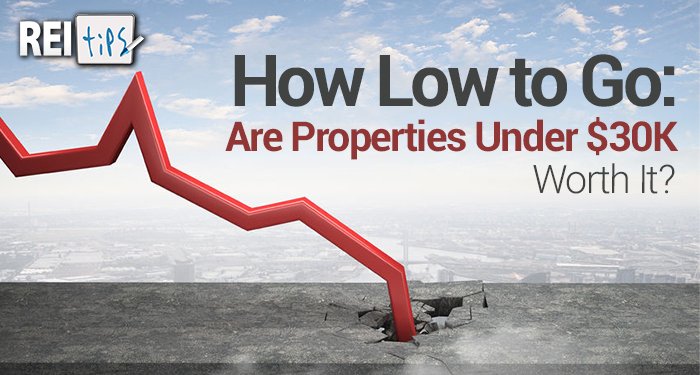“One man’s trash is another man’s treasure.”
~English proverb
The ability to determine which risks are worth the – well – risk.
Investing in low-priced properties (I’m talkin’ $30K and under) is one area of risk that you may or may not have considered. Depending on the housing prices in your market of choice, investing in these types of properties may not even be a possibility.
But if this sounds interesting to you, make sure you keep one thing in mind: When you invest in ultra-affordable properties under $30K, you are increasing your risk. Plain and simple.
Depending on your area of the country and local market, properties at this price point may:
- Be located in a neighborhood that’s considered “bad” or dangerous
- Have a long list of major repairs that could break your budget
- Be difficult to rent out; which could result in irresponsible tenants
And here’s the big BUT…
BUT, if you handle these super-affordable property deals correctly, you can create steady revenue streams that set you up for success. In the long run, you may even achieve your ultimate financial goals.
Still, this investing strategy in one that requires a lot of research, planning and careful choices before you will see the results you’re hoping for. So, let’s take a look at some aspects of investing in low-priced properties that can make you successful.
Location, Location, Location
If real estate investing is a hyper-local business, then investing in properties less than $30K is a hyper-hyper local business.
Not only is the neighborhood important to consider but you also need to think about how the houses differ from block to block.
This is why I wouldn’t recommend investing in ultra-affordable properties unless you are local to the area and know it WELL. This is usually not the type of investing you want to do from another city or state.
Most likely, the properties you’ll find for less than $30K are going to be in C-class neighborhoods – or worse. Just a few steps across a street can switch you from an “okay” neighborhood to a “bad” one.
So be aware of this as you scout out potential property deals.
On the Lookout: How to Find These Properties
If you’ve made the decision to invest in ultra-cheap properties, you’ll want to have a solid strategy for finding the best ones.
At this price point, properties are often either snatched up immediately or left to sit on the market for months and even years. So, it’s important to find the best ones before other investors do – and to avoid the “duds” that are financial disasters waiting to happen.
It’s critical to network as much as you can. Talk to EVERYONE about the types of homes you invest in – your:
 doctor
doctor dentist
dentist UPS delivery guy
UPS delivery guy kids’ teachers
kids’ teachers barber
barber contractor
contractor friends
friends
You never know when someone may stumble upon a property deal that might be the perfect fit for you. Make sure you’re the first person they call!
For properties under $30K, I’d also recommend browsing Craigslist daily – if not several times per day. As I mentioned earlier, if you don’t act almost instantly on these properties, you might miss out.
To Buy or Not to Buy…
Once you’ve found a potential deal, obviously you need to do your due diligence and determine if it’s the right fit for you (as you should do with properties at any price point).
The first item on your checklist should be ensuring that the neighborhood and area is safe. No matter how cheap a property is, if it’s in what we call a “war zone,” it’s just not worth the risk.
I’ve gathered a couple of helpful tips from fellow investors that I’d like to share with you. These are insightful pieces of advice that I think every investor should consider.
 Look for good neighborhoods with bad schools.
Look for good neighborhoods with bad schools.
The quality of the local school district will dictate home prices. When searching for homes priced at $30K or less, look for neighborhoods with working-class people and little crime, but that may be in a less desirable school district. In many cases, the people who live in these neighborhoods are looking for a safe place to raise their families, and they consider the local public school to be just fine. These types of communities will be your best bet for finding affordable properties that won’t be high-risk. Call the local police station.
Call the local police station.
If you’re unsure about the safety of a particular neighborhood, call the local police department and ask to speak with the chief. Mention that you’re planning to buy a home in the area, give the specific address and ask the officer, “If your loved one were buying this house, would you feel okay about them living in this area?” If he or she says “no,” that’s your answer.
First of all, when you look at the sale history of the property, be sure to also consider the tax rates. Plenty of smart investors have screwed themselves over by purchasing a property where the annual tax is the same as 3 months (or more) of rent payments. This is just too high of a risk to take, considering that you’ll also need money for property maintenance throughout the year.
Next, do a thorough – and I mean thorough – analysis of the repairs that will be needed to make the property safe, habitable, presentable and desirable to the types of tenants you want. As a general guideline, never plan to spend more than 10% of your purchase price on repairs and renovations.
So, for a $30K property, you’d want to spend no more than $3,000.
If you realize that major repairs are needed – roof, HVAC, foundation, etc. – that’s probably your sign to bow out of the deal. A new HVAC system, for instance, is going to cost roughly the same for a $30K house or a $300K house – it doesn’t matter. Don’t get yourself caught up in major repairs that are going to leave you in the red zone.
If everything checks out, and the property seems like a wise financial decision, you’ll be ready to look for potential tenants.
The Third Degree: Finding Tenants
Now, with any property you plan to rent out, screening tenants is essential. But with these ultra-affordable properties, a very thorough screening is especially crucial.
In fact, you might even want to run test ads on Craigslist before you even make an offer on the property. (Keep in mind, this could cost you valuable time; but it could also spare you from making a bad decision). By running a test ad (“seeking tenants”), you can quickly determine the housing demand and rental rates for the area.
Then, once you’ve received an accepted offer, you can start thoroughly screening your potential tenants. Again, this is not something that you want to rush through. Finding a loyal tenant who respects the property and pays their rent on time is GOLD – it’s a process that deserves time and effort.
One final piece that you want to have in place – before investing in properties under $30K – is a highly reliable team of people (property manager, contractors, etc.) that you can count on.
Building a Strong Team
No matter how thoroughly you screen your tenants, with properties at this price, you’re probably going to run into difficult people who cause you some grief.
Enter… the experienced and skilled property manager. If you don’t have the ability to manage the tenant and property yourself, this is someone you HAVE to invest in. A good property manager will ease a great deal of your tenant-induced woes.
You also want to have a trustworthy contractor (or several) who you can rely on. Virtually none of the properties at this price point will be move-in ready. Build a solid relationship with a contractor who you know will do high-quality work without charging you an arm and a leg.
It’s also a good idea to form a reliable relationship with a lawyer, as well. (And again, this is the case with any property investment you make – but especially for those that will be rented out to tenants).
Once you have these people “on your side,” it will make the somewhat risky investment in a low-priced property much less hazardous.
Show Me How
While it can seem pretty daunting to venture into the world of investing in ultra-cheap properties, know that you can be successful – you just need to be smart.
I’m always interested to hear stories about real investors who have boldly gone where no other investors have gone before… and succeeded.
So here are a couple of real-life scenarios that I think you might find to be helpful, especially when deciding if investing in inexpensive properties is right for you.
Investor #1 buys homes at a variety of price points in his market, a larger city. His cheapest property yet was purchased for only $3,400. It was owned by the city, and was in a C neighborhood (but not dangerous). The city estimated that the home needed approximately $16K in repairs, minimum, but the investor only put about $10K into the house.
The investor went the Section 8 route, and rented the home for middle $600s/month. In the end, he estimates that he’ll see about $50K-68K minimum return on his investment over the next 10 years.
Now, this is probably a rare example of how a property that cost the investor only about $15K turned into a very profitable decision. But, it’s not impossible!
Check out this other scenario:
Investor #2 bought a HUD property, located in a solid B neighborhood in a small town, for just over $32K. He put $12K into repairs and upgrades (for a total investment of $44K). He was able to find a good tenant immediately, and rented the home out for $700/month. In just over 5 years, he’ll make his money back, and be taking in 100% profit from there on out.
This investing strategy can work well in cities or small towns/rural areas. But keep in mind that – regardless of the town size – the neighborhood has to be the right fit.
Summing it Up
Just like any investing niche, this strategy of purchasing ultra-affordable homes is not for everyone.
If you’re a brand-new investor, for example, you probably don’t want to take this chance. It will probably take several years of experience in your unique market before you’re familiar enough with the industry and the area to make this type of investment.
Also, if you’re not willing to deal with tenants, and don’t want to hire a property manager, this – again – is not a good idea for you.
But, if you know your market well, and are willing and financially able to take somewhat of a risk, this could be a perfect way to branch out. After all, you’re spending less on the property, so the opportunity for financial gain, if the house and tenants are managed properly, is HUGE.
How Low Can You Go?
What was the lowest-priced property you ever bought? What factors went into your decision to make the investment? Let me know in the comments section below.




